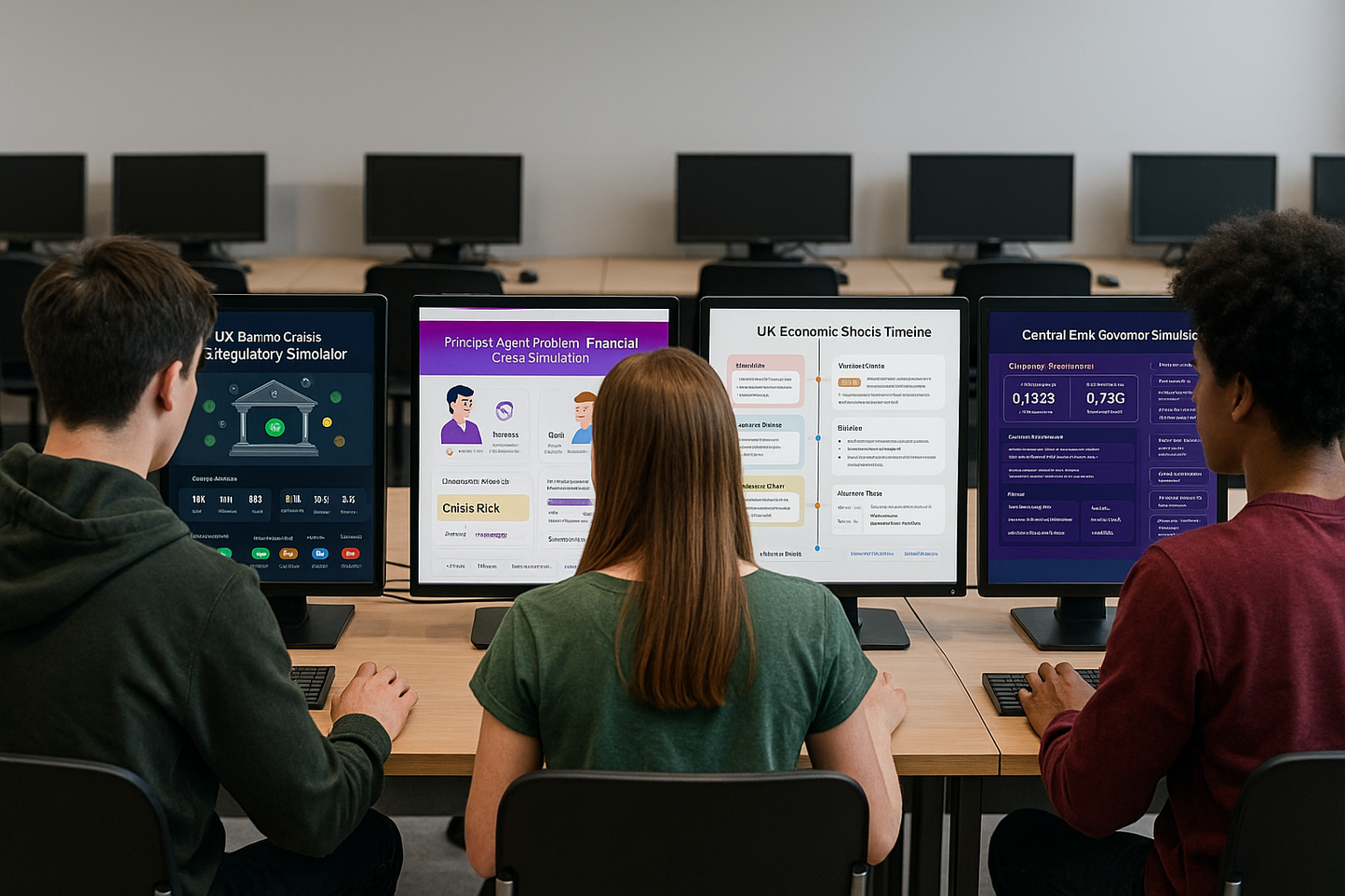BIZ-OMICS
Economics: Central Bank and Financial Markets Bundle
Economics: Central Bank and Financial Markets Bundle
Couldn't load pickup availability
Experience four powerful, browser-based simulators that bring economics to life — from global financial shocks and central banking decisions to principal-agent dilemmas and UK banking regulation. Designed for A-Level learners, each interactive tool blends real-world scenarios, rich data visuals, and engaging quizzes to deepen understanding and spark critical thinking.
Governor of the Central Bank Simulator:
Become the Central Bank Governor and steer the UK economy through inflation, unemployment, and GDP challenges. Students make interest rate decisions, implement QE/QT, and respond to news events—just like the real MPC.
Learning Outcomes:
Understand the role and tools of monetary policy (interest rates, QE/QT, guidance).
Balance competing objectives such as inflation targeting, employment, and growth.
Respond to external shocks like currency speculation, banking stress, or oil prices.
Develop strategic thinking and macroeconomic reasoning over multiple quarters.
The Bank Run Simulator
At its core, the simulator models a bank that holds only a fraction of deposits as liquid reserves, with the rest lent out as illiquid loans. Players can adjust the reserve ratio and panic levels, spread rumors, or trigger full-blown panics. Depositors, represented as individuals, shift between calm, concerned, and panicked states depending on overall sentiment and contagion effects. As panic spreads, withdrawals drain reserves, potentially leading to bank failure. The user can test policy tools like central bank bailouts (injecting liquidity), deposit insurance (reducing panic), or capital controls (limiting withdrawals).
One of its greatest strengths is that it translates abstract theory into a hands-on, visual experience. Instead of passively learning about liquidity transformation and coordination problems, students see how a healthy bank can collapse under fear, and how interventions alter outcomes. It captures the non-linear and self-fulfilling nature of bank runs, showing how identical banks may either survive or fail depending on depositor expectations.
Another benefit is its exploration of trade-offs. For example, capital controls might buy short-term stability but increase panic later, while bailouts restore liquidity but risk moral hazard. Deposit insurance reassures savers but raises questions about incentives for prudent banking. By experimenting with these scenarios, learners begin to appreciate the policy dilemmas regulators face in real crises.
UK Banking Crisis & Regulatory Simulator:
Step into the shoes of a financial regulator managing a bank through turbulent economic scenarios. From the 2008 Financial Crisis to COVID-19, students explore the cause-and-effect relationships of shocks, regulation, and recovery in the UK banking system.
Learning Outcomes:
Understand the role of capital adequacy and liquidity in banking stability.
Analyse the impact of different types of financial crises (e.g., Northern Rock, Brexit, COVID-19).
Evaluate policy tools like Quantitative Easing, capital buffers, and stress tests.
Develop insights into the role of trust, confidence, and regulation in financial systems.
Principal-Agent Problem: Financial Crisis Simulator:
Students model the decision-making of mortgage applicants, brokers, and investment banks in the lead-up to the 2008 crisis. The simulator visualises how moral hazard, misaligned incentives, and information asymmetry build systemic risk.
Learning Outcomes:
Define and apply the principal-agent problem in a real-world context.
Explore moral hazard and asymmetric information in mortgage lending.
Simulate the build-up to the subprime mortgage crisis.
Evaluate the consequences of deregulation and poor due diligence.
Global Financial Shock Timeline Simulator:
This immersive digital timeline introduces students to major global economic shocks from 1929 to 2022.
Learning Outcomes:
Analyse the causes and consequences of key global economic disruptions across time.
Interpret key macroeconomic indicators such as inflation, GDP contraction, unemployment, interest rates, and government debt.
Develop the ability to compare crises across time and geography, identifying patterns and shifts in economic thought and policy.
Profit & Liquidity Scale
The Profit & Liquidity Scale is an interactive learning game designed to transform abstract financial concepts into a hands-on, memorable experience. By challenging learners to drag and drop financial products into the correct order, it bridges theory with practice, allowing students to actively engage with the concepts of profitability and liquidity rather than simply memorising them.
Players are tasked with arranging items from highest to lowest across two dimensions: profitability and liquidity. This dual-focus design highlights the trade-offs between earning potential and accessibility of funds, which is at the heart of financial decision-making. As students test, reset, and refine their answers, they build a deeper understanding of how different financial products behave in real contexts. The use of hints, instant feedback, and animated celebrations keeps motivation high while reinforcing correct reasoning.
Share


